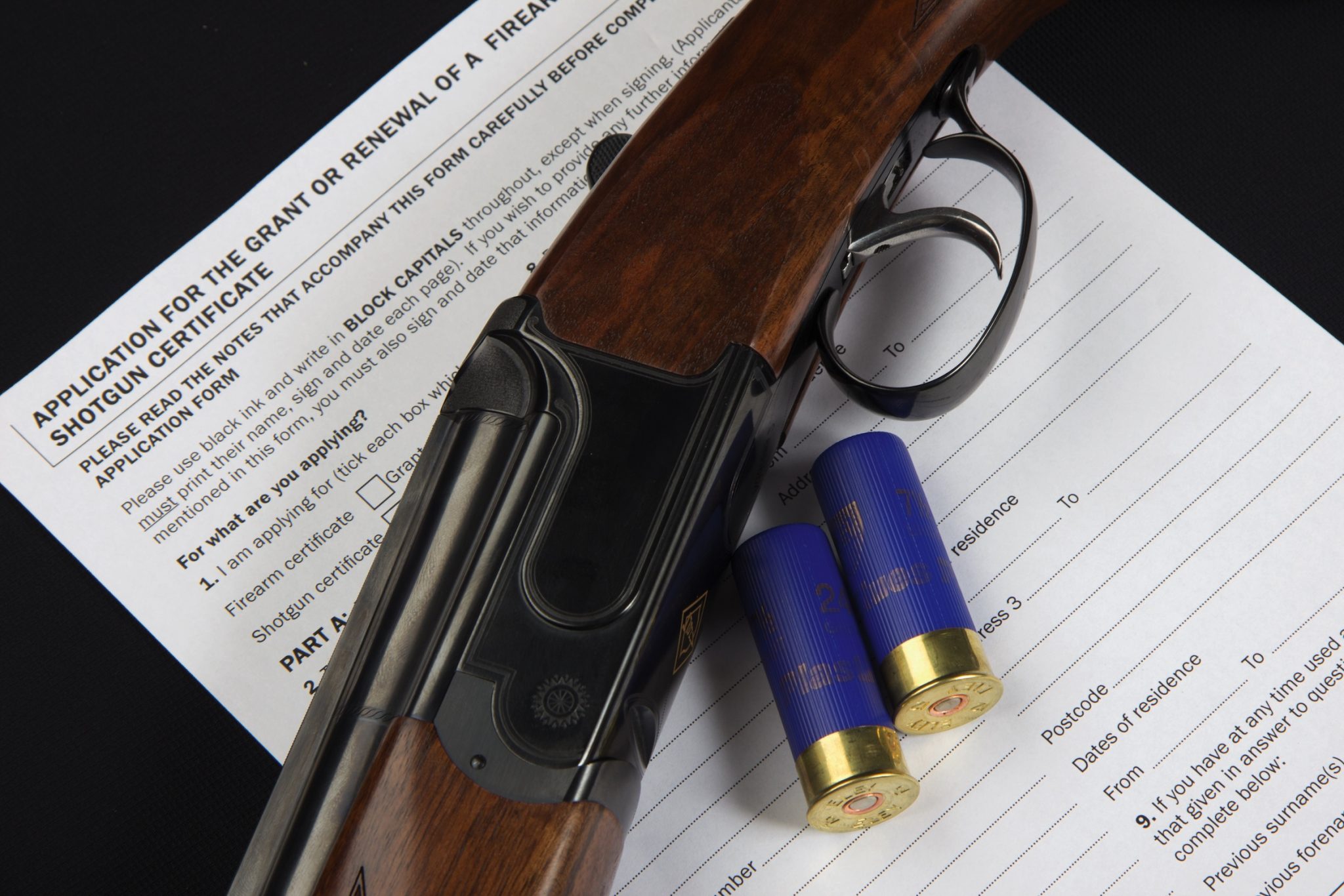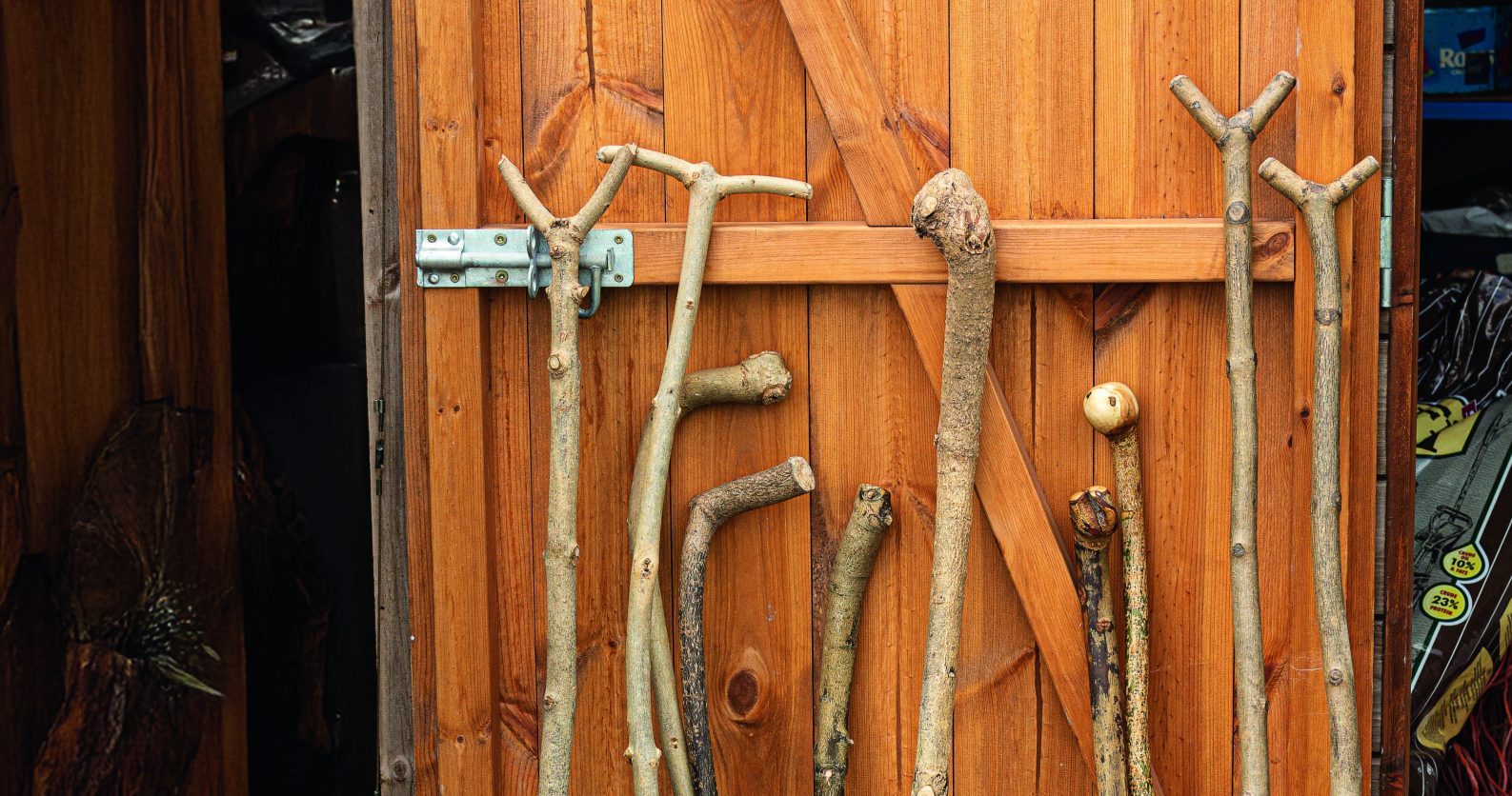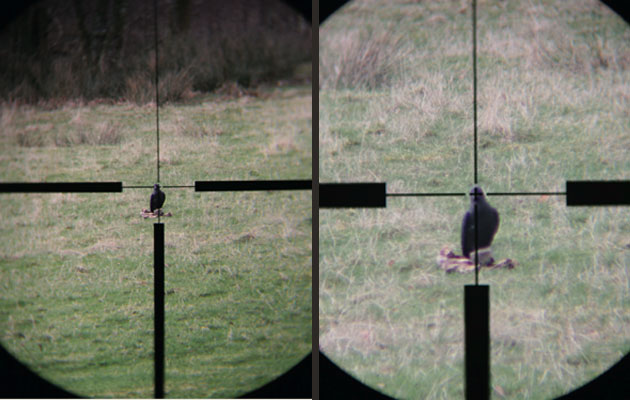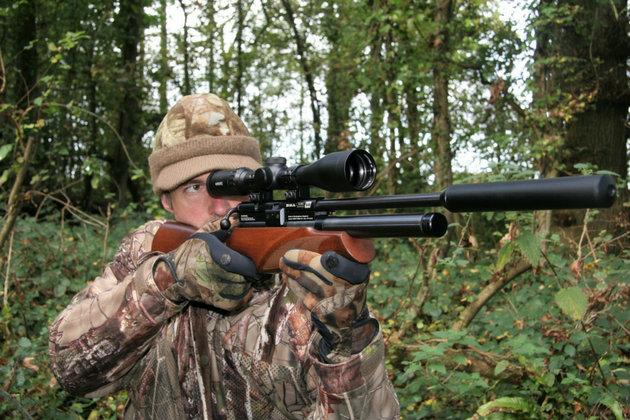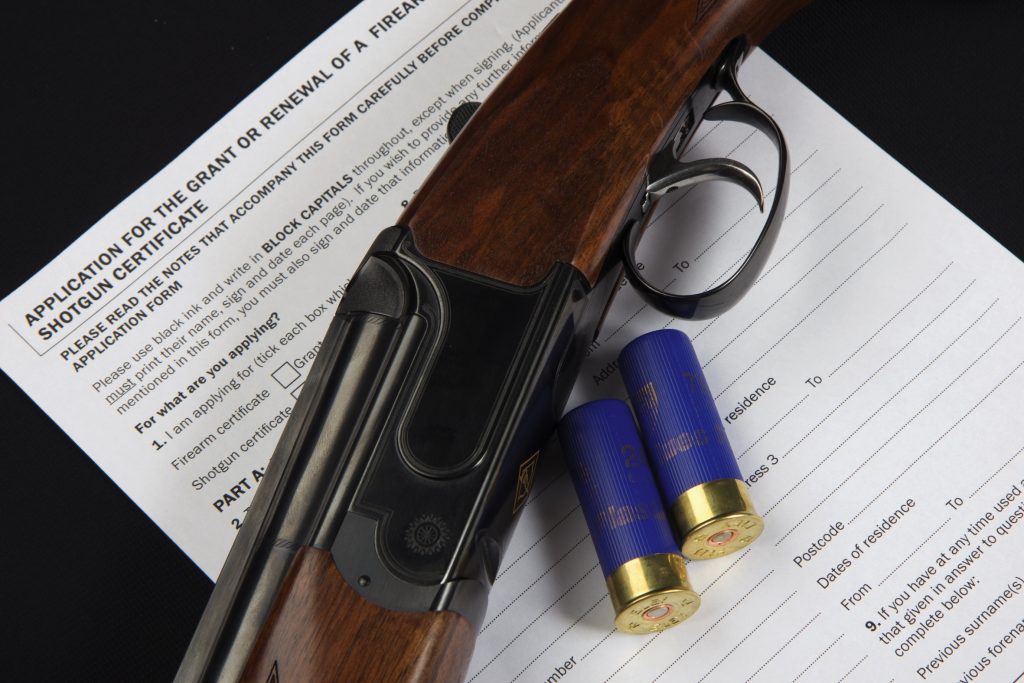Many rifle shooters don’t really understand the difference between focal planes and it’s an aspect of rifle scopes that is…
Win CENS ProFlex DX5 earplugs worth £1,149 – enter here
Hawke Sidewinder FFP
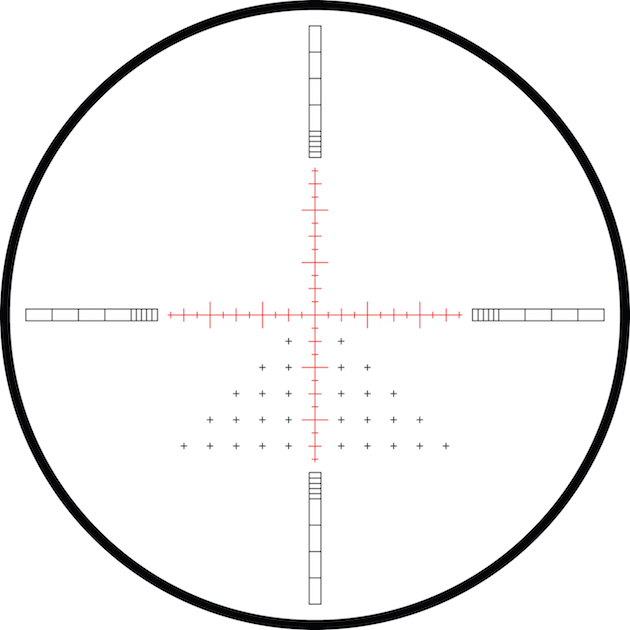 Equipped with numerous aim-points, Hawke’s FFP Mil reticle has been designed for first focal plane use.
Equipped with numerous aim-points, Hawke’s FFP Mil reticle has been designed for first focal plane use.
It wasn’t very long ago that first focal plane (FFP) scopes were regarded as something of a niche product. There has been a shift over the years as more shooters cotton on to the advantages these optics offer. Hawke is never slow when it comes to offering customers exactly what they want, so it is no surprise to see its proven Sidewinder range bolstered by a pair of FFP scopes.
For those who aren’t familiar with FFP scopes, these optics are configured with the reticle in front of the magnification lens. This means that, as the level of magnification is wound up or down, the size of the reticle changes in proportion with the target. The result is that the various aiming points you use to apply hold-over or hold-under to ensure that shots remain on target over varying ranges remain exactly the same whatever magnification setting you use. This is very handy for shooters like me who like to zoom in and out for different shooting scenarios. I’ve found it useful with my rimfire and even more so when compensating for the curved trajectory of a sub-12ft/lb air rifle.
The Sidewinder FFP is available in 6-24×50 and 4-16×50, and the latter is the subject of this review. Tipping the scales at 810g and measuring about 37cm from end to end, and equipped with a substantial 50mm objective lens and chunky 30mm tube for improved light transmission, it is not a compact scope but it didn’t feel unwieldy when mounted on my Weihrauch HW100 carbine.

Equipped with numerous aim-points, Hawke’s FFP Mil reticle has been designed for first focal plane use.
Features
• First focal plane optical system
• Illuminated FFP Mil reticle
• Fast-action locking target turrets
• 18 layers of optical coating on lenses
• Side parallax wheel with
10cm dial and pointer
• Smooth zoom adjustment
from 4 to 16x
• Clear, bright sight picture
• Monotube chassis
• Metal flip-up lens covers,
sunshade and optical
cloth supplied
• Water, shock and fog proof
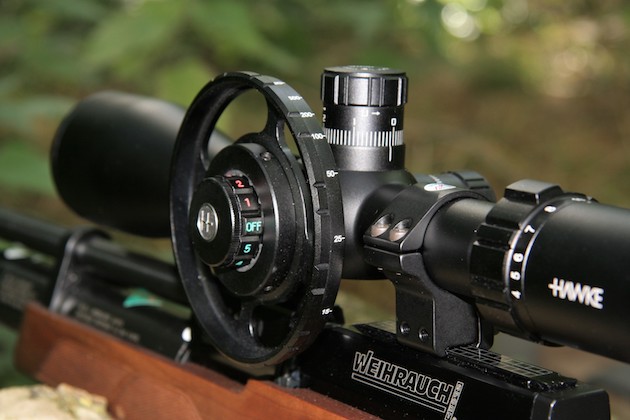
Fit the supplied 10cm oversize parallax wheel for precise focusing and range estimation.
Zeroing
Zeroing is quick and easy, thanks to the finger-adjustable target-style windage and elevation turrets. Pull them up to unlock them and they turn with positive stops to give 1/10 MRAD adjustment per click. Once you are zeroed in, the turrets simply snap back down to lock securely in place.
This scope is equipped with Hawke’s glass-etched FFP Mil reticle, designed specifically for first focal plane use. This reticle offers 11 aiming points along each of the four elements of the vertical and horizontal cross-hairs, plus another 30 set out in a Christmas tree configuration in the lower half of the sight picture. I would have preferred it without all those additional markers. I find busy reticles something of a distraction, and this arrangement does look cluttered when it is scaled right down at lower magnification. At 7x and above, it was easy enough to decipher and I’m sure lots of shooters will appreciate all those reference points. One big plus point is the fact that the reticle is nice and fine, so precision isn’t compromised when it is scaled-up on the higher magnification settings.
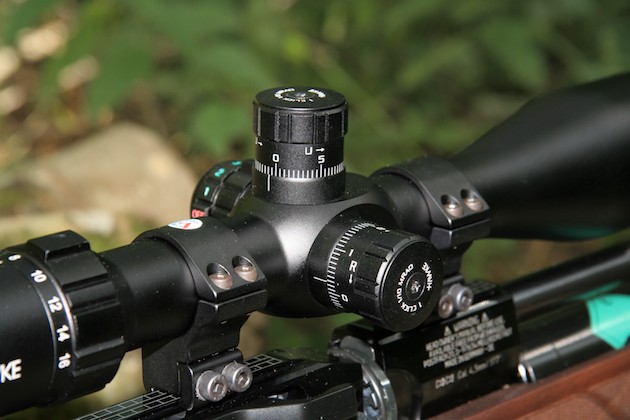
Target-style locking turrets facilitate fast and precise zeroing without tools.
Eye relief
- Eye relief is 9cm and the fast-focus ocular ring ensures that the reticle is set pin-sharp for your eye.
- You can dial out parallax error and keep the target in crisp focus courtesy of the side-mounted dial opposite the windage reticle. It focuses smoothly from 10 yards to infinity, and comes supplied with an oversize 10cm wheel and pointer for added precision when estimating range when the target snaps into focus at higher magnification.
- The turret that houses the parallax dial also incorporates a rheostat switch to operate the illuminated reticle. It offers five levels of brightness to light up the vertical and horizontal cross-hair elements in red or green. This feature is handy when shooting in low light conditions, and I even used it in full sunlight to improve precision when shooting woodpigeons that were silhouetted against a bright sky.
- Being able to wind magnification up or down to suit different hunting scenarios is a real asset, and the Sidewinder’s grooved zoom dial turns smoothly while having sufficient torque to prevent accidental adjustment.
- The 4-16x zoom range is a good choice for general airgun hunting. Set on 10x, it is good for typical daylight sessions, while 6x offered improved light transmission and a wider field of view when lamping rats.
- The top setting of 16x was more than adequate for long-range bipod work. Field of view shifts from 7.7m to 2.2m at 100m from lowest to highest magnification.
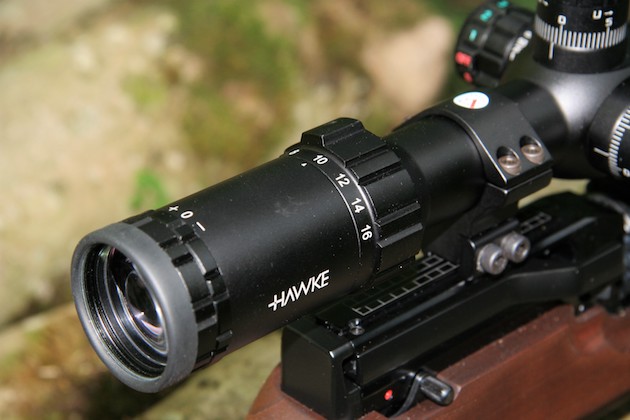
The chunky grooved zoom dial makes for smooth and positive magnification adjustment from 4 for 16x.
Conclusion
The Sidewinder FFP is a robust piece of kit. It is nitrogen-purged to seal out water and prevent it from fogging up, and it is shock-proofed to withstand recoil. The full kit includes scope, 10cm parallax sidewheel and pointer, 10cm sunshade, metal flip-up lens covers, lens cloth and CR2032 battery. That is an impressive list of extras but this scope’s price tag is already more than justified by its optical performance. It is certainly worth a look if you are a shooter who uses various magnification settings over a variety of ranges and want the reassurance of knowing that your aiming points won’t budge when you make those adjustments.
Contact Hawke for stockists
Hawke Vantage Scope 3-12×44 SF
Not everyone can afford top-end optics, and even those who can may still struggle to justify shelling out big money…
£189.99
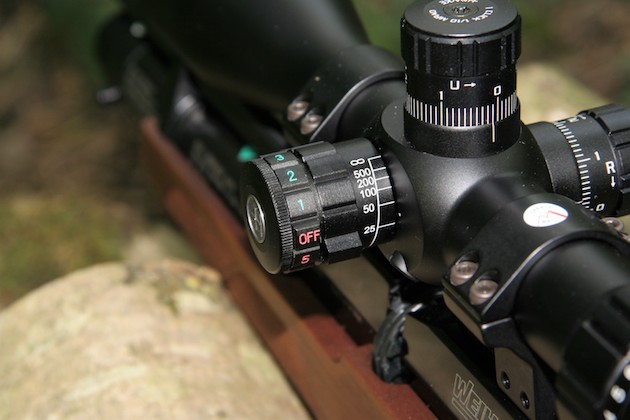
The turret that houses the parallax dial also features a rheostat switch to control the illuminated reticle.
Standout features
First focal plane reticle remains in proportion to target when magnification is wound up and down.
• Finger-adjustable target-style locking turrets make for simple zeroing with 1/10 MRAD adjustment per click.
• Rheostat switch (below) provides five levels of reticle illumination
in red or green.
• Side parallax dial ensures quick
and smooth focusing down to just
10 yards, and can also be used for
range estimation.
• 50mm objective lens and 30mm tube optimise light transmission.
• 4-16x zoom range covers a variety
of shooting scenarios, from close-range ratting to long-range bipod work.
Related Articles
Get the latest news delivered direct to your door
Subscribe to Shooting Times & Country
Discover the ultimate companion for field sports enthusiasts with Shooting Times & Country Magazine, the UK’s leading weekly publication that has been at the forefront of shooting culture since 1882. Subscribers gain access to expert tips, comprehensive gear reviews, seasonal advice and a vibrant community of like-minded shooters.
Save on shop price when you subscribe with weekly issues featuring in-depth articles on gundog training, exclusive member offers and access to the digital back issue library. A Shooting Times & Country subscription is more than a magazine, don’t just read about the countryside; immerse yourself in its most authoritative and engaging publication.




